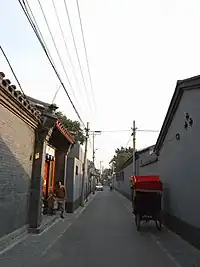The following is a list of hutongs in Beijing, People's Republic of China:
Beijing Hutong is the product of long history, it reflects the face of Beijing history is rich in content. Hutongs in Beijing are not only the veins and traffic channels of the city, but also the places where ordinary people live and the important stage of the historical and cultural development of Beijing. It records the historical changes, the style of The Times, and contains a strong cultural flavor, like a folk customs museum, branded with the imprint of people's various social life. A brick or tile in many hutongs is hundreds of years old. One can understand the life of Beijing residents from the hutong courtyards, large and small, including their lifestyle, life interests and neighborhood relations.[1]

- Bada Hutong
- Dongjiaominxiang Hutong, the longest hutong
- Fengfu Hutong
- Guozijian Street
- Jinyu Hutong
- Jiuwan Hutong
- Ju'er Hutong
- Lingjing Hutong, the widest hutong
- Liulichang Street
- Mao'er Hutong
- Nanluoguxiang Hutong
- Qianshi Hutong (Money Market), the narrowest hutong
- Xijiaominxiang Hutong
- Yandai xiejie
- Yichi Dajie (One Foot Street), the shortest hutong
- Zhuanta Hutong (Brick Pagoda Hutong)
- Doufuchi Hutong
- Beiluoguxiang
- Lishi Hutong
- Yancao Hutong
- Yanle Hutong
- Bensi Hutong
- Neiwubu Hutong
- Shijia Hutong
- Ganmian Hutong
- Dongtangzi Hutong
- Xizongbu Hutong
- Xinkailu Hutong
- Beijige Santiao
- Beijige Toutiao
- Suzhou Hutong
- Hougou Hutong
- Chuanban Hutong
- Shoupa Hutong
- Shiban Hutong
- Xiaoxinkai Hutong
References
- ↑ "北京胡同(北京标志性建筑之一)_摘编百科". www.zhaibian.com. Retrieved 2023-04-21.